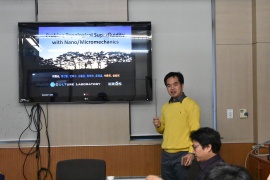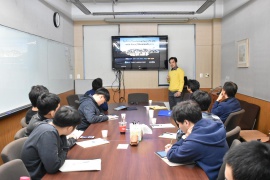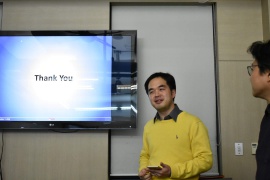Probing Topological Superfluidity with Nano/Micromechanics: Difference between revisions
Mahnsoo.choi (talk | contribs) m (Protected "Probing Topological Superfluidity with Nano/Micromechanics" ([Edit=⧼protect-level-board⧽] (indefinite) [Move=⧼protect-level-board⧽] (indefinite))) |
LeeMyeongwon (talk | contribs) No edit summary |
||
| Line 8: | Line 8: | ||
Topological matters have drawn the focus of condensed matter physicists for the better part of past decade. Topological superconductors have been of particular interest due to their potential to host the so-called Majorana fermions, an elusive particle whose anti-particle is the particle itself. Most of the efforts have revolved around synthesizing a new breed of topological superconductors by combining topological insulators, superconductors and magnetic materials. A more naturally produced topological superfluid, 3He, on the other hand, has been considered to be more difficult to probe due to its charge neutral nature. Nano/micromechanical systems provide a new path for studying topological superfluidity in this charge neutral system and we have developed NEMS/MEMS devices for this purpose. In this talk, I will discuss how NEMS/MEMS devices can be used in topological superfluid research and report our progress. | Topological matters have drawn the focus of condensed matter physicists for the better part of past decade. Topological superconductors have been of particular interest due to their potential to host the so-called Majorana fermions, an elusive particle whose anti-particle is the particle itself. Most of the efforts have revolved around synthesizing a new breed of topological superconductors by combining topological insulators, superconductors and magnetic materials. A more naturally produced topological superfluid, 3He, on the other hand, has been considered to be more difficult to probe due to its charge neutral nature. Nano/micromechanical systems provide a new path for studying topological superfluidity in this charge neutral system and we have developed NEMS/MEMS devices for this purpose. In this talk, I will discuss how NEMS/MEMS devices can be used in topological superfluid research and report our progress. | ||
<gallery mode="packed-hover"> | |||
Image:H-S_Choi_Seminar_1.jpg | |||
Image:H-S_Choi_Seminar_2.jpg | |||
Image:H-S_Choi_Seminar_3.jpg | |||
</gallery> | |||
[[Category:Condensed Matter Seminars]] | [[Category:Condensed Matter Seminars]] | ||
[[Category:Seminars]] | [[Category:Seminars]] | ||
Latest revision as of 12:29, 28 November 2018
- Speaker: Prof. Hyoungsoon Choi (KAIST)
- Date: Wednesday, November 7, 2018, at 17:00
- Place: Jungho Seminar
Topological matters have drawn the focus of condensed matter physicists for the better part of past decade. Topological superconductors have been of particular interest due to their potential to host the so-called Majorana fermions, an elusive particle whose anti-particle is the particle itself. Most of the efforts have revolved around synthesizing a new breed of topological superconductors by combining topological insulators, superconductors and magnetic materials. A more naturally produced topological superfluid, 3He, on the other hand, has been considered to be more difficult to probe due to its charge neutral nature. Nano/micromechanical systems provide a new path for studying topological superfluidity in this charge neutral system and we have developed NEMS/MEMS devices for this purpose. In this talk, I will discuss how NEMS/MEMS devices can be used in topological superfluid research and report our progress.



